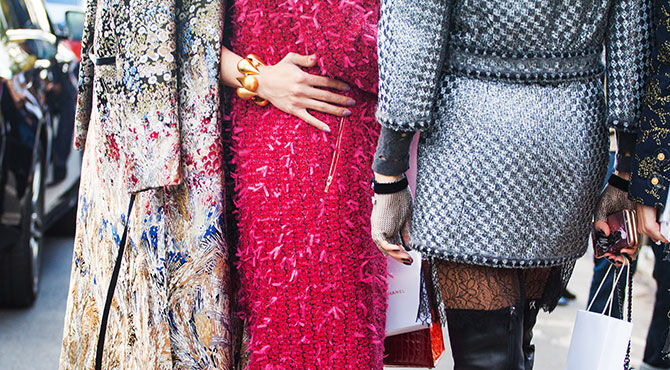Fashion and clothing – a globally mobile industry
Fashion is booming, despite facing a number of significant challenges. How is the industry adapting to change and what other businesses can learn from it?

How fashion became agile
The growth of online retailing has been a significant challenge for traditional retailers. Many have been forced to 'self-disrupt' and invest in omnichannel strategies as footfall declines on the high street. McKinsey’s report, The State of Fashion 2019 – a collaboration between The Business of Fashion and McKinsey & Company – found that social media is an increasingly important voice in dictating consumer demand and it is helping small brands to grow explosively.Increasingly important priorities are sustainability and transparency, reflecting rising concerns on the part of consumers and companies. For some forward-thinking companies, sustainability has become engrained in their business model and ethos.Alistair Green, chief strategy officer at Studio Blvd, whose clients include River Island, Sweaty Betty, Ben Sherman, COS and Carolina Herrera fragrances, believes the industry is going through “significant change”. He says, “According to figures published by the Department for Digital, Culture, Media & Sport, Britain's major creative industries (film, music and advertising) are valued at £101.5 billion, growing by a jaw-dropping 53% since 2010.“Behind the strong growth, however, lies significant change. In advertising, the behemoths of J. Walter Thompson and Young & Rubicam (with more expected to follow) are being not just rolled into, but rolled under, the new banners of digital agency Wunderman and digital network VML.”Green says the UK's creative industries are growing, while old is being replaced by new at a pace never seen before. “The digital tipping point has arrived and the frontrunners of this new age are stomping all over those who have failed to keep up,” he adds.The secret of survival
Being prepared to embrace change, taking into account new shopping preferences, listening to the needs of young consumers and being able to deliver your products faster than ever before, are some of the ways to survive in such a competitive trading environment.“The fashion industry is extremely valuable to the UK economy, one of our biggest industries in terms of employment and job opportunities,” says Bethany Hamer of JulesB, an online and bricks-and-mortar clothing retailer, which has won the Drapers Best Independent Fashion Retailer in Britain award on three occasions. “Fashion is a global industry and although we are based in the North of England, we operate globally,” she says. “We ship internationally and we have a burgeoning customer base in the UAE. We will continue to diversify our operation to benefit our international customers through e-commerce. We think globally too, which directly relates to how we choose brands for the business and how we market ourselves.”In the new world of shopping, retailers need a slick online operation and reliable delivery service. “Our digital presence is growing and social media engagement knows no borders,” Hamer says. “We want to continue to be a part of the international fashion community and conversation.”While the Brexit issue is still unresolved, it is hard to predict what effect it will have on the UK’s place at the heart of global fashion. Current trade in finished fashion goods between the EU and the UK is worth $23 billion (roughly 5% of the total European fashion market and 1.3% of the global fashion market, according to the McKinsey report). McKinsey believes that the UK textiles, apparel and footwear industry will be one of the hardest hit in terms of the impact of the UK leaving the EU in March 2019. “Some 63% of clothing designers and 55% of UK-based luxury goods makers are involved in exports and around 10,000 EU citizens are employed in the UK fashion industry,” it says.“The British fashion industry relies on international trade, so the extent to which the industry is impacted really depends on the scenario and any ‘deals’ agreed to,” Hamer says. “Whatever and however it happens, it does seem likely that prices of imported goods will be impacted and that the industry’s access to European talent will, unfortunately, become more limited.”Hamer acknowledges that this has made it difficult for an industry that often operates six months to a year ahead in terms of planning and design. “As an industry that works so far in advance, it is tough in fashion at the moment, because we know so little regarding the details. Obviously this is going to have an impact on exactly how we proceed,” she says. “The UK fashion industry’s focus must be on encouraging home-grown designers and entrepreneurs, while remaining accessible to international talent and allowing young people from the EU and beyond to continue studying, working and thriving here in Britain. This is what will allow us to remain competitive.“It is difficult to know at this point how much we will be impacted, but we hope to see the same exceptionally high level of talent coming out of Britain and we hope that our relationships with international brands remain strong.”Accountability, sustainable textiles and anti-slavery
While fashion brands are grappling with the migration to online sales, they are also under pressure to make their products more sustainable. Among younger consumers in particular, there's an increasing focus on how and where clothing is made. Analysis by Fashion Revolution – a movement that is campaigning for a more transparent fashion industry – found that out of 98 brands and retailers reviewed in 2017, there was a 5% average increase in their level of transparency in 2018.The campaign was started as a reaction to Rana Plaza, the Bangladeshi clothing factory that collapsed in April 2013, which killed at least 1,132 people and injured more than 2,500. It provoked widespread shock at the conditions in which people were working who were supplying clothing to the UK and European markets.Elsewhere, questions are being asked about the cost of producing textiles such as cotton and the impact of the dyeing industry. In many countries where there are poor or absent government controls, textile factories dump toxic waste water directly into rivers. There has been a recent focus on the desertification of the Aral Sea, where cotton production has drained away the water, creating a huge impact on the local population.The International Labour Organization estimates that 170 million children are forced to work, many of them in the textile and garment industry, which supplies consumers in Europe and the US. A report by the House of Commons environmental audit committee found that UK shoppers each buy an average of 26.7kg of new clothes every year – more than any other country in Europe.Future of fashion
Survival in the fashion industry in 2019 will require a combination of business acumen and sensitivity to changing consumer demands. “For fashion players, 2019 will be a year of awakening,” says McKinsey in its report. “Regardless of size and segment, players now need to be nimble, think digital-first and achieve ever-faster speed to market. They need to take an active stance on social issues, satisfy consumer demands for ultra-transparency and sustainability, and, most importantly, have the courage to 'self-disrupt' their own identity and the sources of their old success in order to realise these changes and win new generations of customers.”Economic expansion is happening across Asia, but 2019 could be the year in which India will take centre stage. The country is predicted to grow by 8% a year between 2018 and 2022. The Indian middle class is forecast to expand at 19.4% a year over the same period, outpacing China, Mexico and Brazil.As a result, India is set to move from being an increasingly important sourcing hub to one of the most attractive consumer markets outside the Western world. India’s apparel market will be worth $59.3 billion in 2022, making it the sixth-largest in the world and comparable to the UK ($65 billion) and Germany ($63.1 billion), according to data from McKinsey’s FashionScope.However, while concern over trade tensions is rising – for example between the US and China – there are also positive dynamics, with new agreements being put in place and new trade routes being developed. The EU has recently entered into new agreements, including clothing with Canada, Mexico, Japan, Singapore, Vietnam and several countries from Eastern Europe. In September 2018, Canada agreed to join the US and Mexico in a trade deal that will replace the North American Free Trade Agreement.As China’s exports have plateaued, other developing nations with lower wages are stepping in. Apparel exports from Bangladesh, Vietnam and Ethiopia have been growing by double digits annually since 2010. Turkey is also a major producer of clothing that is exported to Europe. Access to talent will be a major success factor, too. The biggest talent gap today is likely to be in digital or advanced manufacturing and managing intelligent sourcing decisions.Subscribe to Relocate Extra, our monthly newsletter, to get all the latest international assignments and global mobility news.Relocate’s new Global Mobility Toolkit provides free information, practical advice and support for HR, global mobility managers and global teams operating overseas. Access hundreds of global services and suppliers in our Online Directory
Access hundreds of global services and suppliers in our Online Directory
©2025 Re:locate magazine, published by Profile Locations, Spray Hill, Hastings Road, Lamberhurst, Kent TN3 8JB. All rights reserved. This publication (or any part thereof) may not be reproduced in any form without the prior written permission of Profile Locations. Profile Locations accepts no liability for the accuracy of the contents or any opinions expressed herein.







































